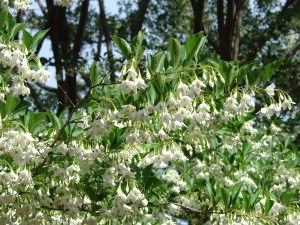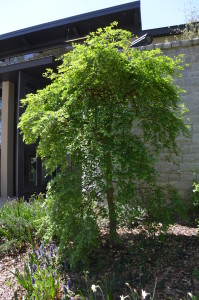Japanese snowbells (Styrax japonicus) is a graceful, slow growing, low branched spring flowering tree. At present snowbells are not popular with U.S. gardeners , mostly because of unavailabliity (USDA hardiness zones 5-8). Snowbells are lovely understory trees, similar to our native dogwoods (Cornus florida). Small, pendulous, slightly fragrant, bell-shaped white flowers appear in May. Small white ½ inch oval-shaped drupe fruits are ornate by late summer.
Site selection is very important! At first spring warmup, snowbells often leaf out too early. They’re are best planted on the north side of a home or building to slowdown spring leaf emergence and possible frost injury to leaves and flower buds. Snowbells grow in full to partial sunlight and are suited to moist, mildly acidic, compost-rich, well-drained soil. Supplemental watering is advised the first two years for establishment. Fertilize in early spring with an organic or slow-release fertilizer designed for flowering shrubs.
Snowbells reach mature heights and widths of 18 to 30 feet, a perfect size for most urban gardens. Cracks or fissures over the gray bark of older branches reveal an orange inner bark, a unique feature on mature specimens during winter. Elliptic-ovate, glossy, 2 to 3 inch long, deep green summer leaves stay generally blemish-free. Most years, fall leaf color is of no consequence, sometimes turning clear yellow.
Snowbells have few disease or pest problems when properly sited and cared for. Fragrant flowers attract hundreds of bees and butterflies.
Notable cultivars:
‘Pink Chimes’ – pink, fragrant flowers on slightly weeping.
‘Emerald Pagoda’ – slightly larger star-like flowers, graceful weeping form.
‘Carillon’ (same as ‘Pendula’) – white with showy yellow stamens flowers and slightly weeping.
In most areas snowbells are still a collector’s plant, rarely sold at local garden centers. E-commerce nurseries are good sources.
Other Snowbell (Styrax) species:
American styrax (S. americanum) – cold-hardy and shrub-like.
Fragrant snowbell (S. obassia) – exfoliating (peeling) bark for winter interest.



 Posted in
Posted in 
